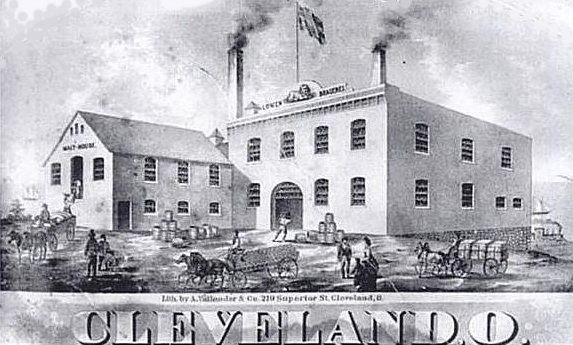I own a book called Brewing in Cleveland, part of the “Images Of America” series. About lager beer, the introduction notes the following:
A huge influx of German immigrants arrived in Cleveland between the 1840s and the 1880s, bringing much of their culture with them. The particular process for the production of lager beer was one aspect, and it would revolutionize the American beer industry within a fairly short time. The first lager beer in America is thought to have been brewed around 1840, and it is believed that it was first brewed in Cleveland in either the late 1840s or the early 1850s.
 This picture is in the book, a lithograph of one of the first breweries “located atop a steep bluff overlooking Lake Erie.” This would make sense. Unlike ale (the type of beer commonly brewed in the U.S. until then), lager beer required fermentation in ice-cold temperatures over a period of several months, so it was only available in the cold season. But with Cleveland situated on the shores of Lake Erie, it had the advantage of an abundant supply of ice (or at least, lager brewers would see the frozen tundra that way).
This picture is in the book, a lithograph of one of the first breweries “located atop a steep bluff overlooking Lake Erie.” This would make sense. Unlike ale (the type of beer commonly brewed in the U.S. until then), lager beer required fermentation in ice-cold temperatures over a period of several months, so it was only available in the cold season. But with Cleveland situated on the shores of Lake Erie, it had the advantage of an abundant supply of ice (or at least, lager brewers would see the frozen tundra that way).
In the early years of lager beer brewing, before refrigeration had made it onto the scene (around the 1880s), huge blocks of ice were sawed out of Lake Erie in the winter, then stuffed in underground caverns to make it possible for year round lager beer production. So no doubt the brewers dug out caves in this “steep bluff” to store their barrels. To learn more about this process, check out Greg A. Brick’s article “Stahlman’s Cellars: The Cave Under the Castle” about German immigrant brewers in St. Paul, Minnesota around the same era.
In general in those years, beer was coming into its own. Until the mid-nineteenth century, Americans had been gulping hard liquor, but the strong movement toward temperance made beer a more acceptable option.
The Germans imported not only their beer, but also their custom of beer gardens. I’ve been thinking about this because summer is just around the corner, so beer garden commercials will soon be on the radio again. In nineteenth century German towns across the U.S., the German beer garden was a typical sight.
The most idyllic depiction of summer beer gardens I’ve come across in my history browsings is this image, found in the Atlas of Cuyahoga County, Ohio, from actual surveys by and under the directions of D. J. Lake, C. E., available online at the Cleveland Memory Project.
It seems summer beer gardens are once again gaining popularity across the U.S. (read more at Lautering). And why not? Count me in!

